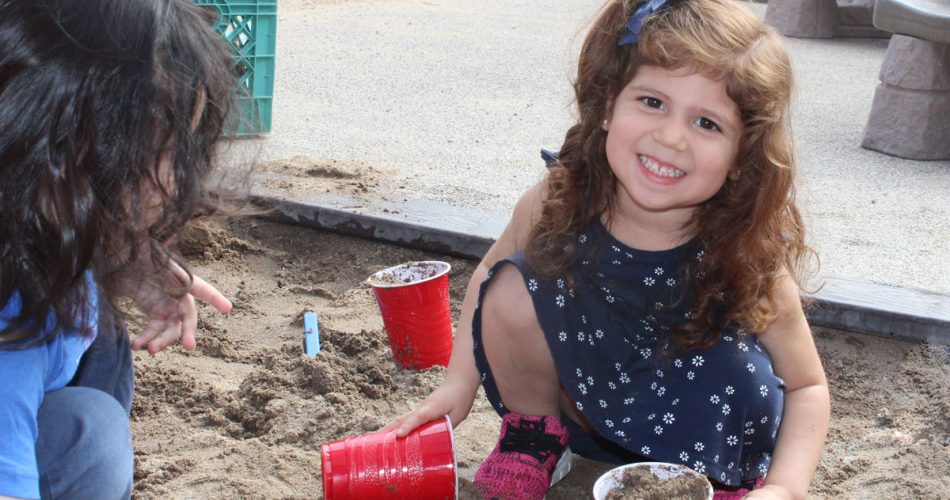Early childhood educators know children learn best through hands-on experiences. You can see the excitement of learning in an infant’s face when rattling a toy or as preschoolers splash at the water table. Your program’s daily routines, transitions and activities can either promote or hinder children’s access to materials. Here are a few tips on how to improve children’s access to materials.
Quality First uses the Environment Rating Scales (ERS-3) to measure the quality of early learning environments. The scales give a snapshot of the learning environment and the children’s experiences in the setting. When completing ERS-3 assessments, one key area is accessibility. Accessibility refers to the time children can touch and use materials freely, without verbal or physical restriction. For items to be considered accessible, children must have choice of what materials to use and how to use them.
The Early Childhood Environment Rating Scale (ECERS-3) is used in center-based preschool settings and looks at accessibility using time. At the minimal (3s) level for most play items, 25 minutes of access is required in a three-hour observation. At the good (5s) and excellent (7s) levels, most items require one hour of access.
The Infant Toddler Environment Rating Scale (ITERS-3) is used in infant and toddler environments in center-based settings. The Family Child Care Environment Rating Scale (FCCERS-3) is used in family child care settings with mixed ages. For these children, most of the day should be spent in play or other things they enjoy. These tools focus less on time stamps and more on the amount of lapses in access.
With All Ages
Limit wait times during transitions
The time children spend in between activities (including lining up and waiting for an activity to start) can add up to a lot of learning time lost over the course of a day. If you work with another adult, ask them to time the transitions in the daily routine. Do children wait for long periods with nothing to do? Consider how to streamline these transitions with these ideas:
- Coordinate hand washing with lunch time arrival so that children aren’t waiting a long time before lunch arrives.
- Have children transition to handwashing in small groups to limit time waiting at the sink.
- When waits can’t be avoided, provide an activity choice for children, such as a short story or song that children enjoy to keep them engaged and learning.
With Preschoolers
Make center-time a free-choice time
If children can only choose from teacher-selected activities, such as Legos and drawing, the variety of skills they can build is limited. If children can move freely around the room and choose materials from a variety of areas, all materials are considered accessible. Consider your center time and whether it allows for choice of a variety of materials.
Offer teacher-led activities as one option
When children are required to do a teacher-directed activity during free play, it limits their access to other materials. Consider offering a teacher-led activity as one option during center time. That way, children can join according to their interests.
With Infants and Toddlers
Limit time in devices
Young non-mobile infants (those that cannot sit unsupported) should spend most of their time interacting with caretakers, exploring and touching materials. To support their motor skills, time spent in restrictive devices, such as seats, cribs and swings, should be limited. Consider how to add more supervised play time on the floor so little ones can stretch out and explore.
Bring materials to baby’s reach
Older non-mobile infants (those that can sit unsupported, but not move freely on their own) should have materials brought to them and have interaction throughout the day. To keep little ones from getting bored, rotate materials often. Put together bins or buckets of toys in advance so you can rotate items during a busy day.
Join toddlers as they explore
Children that can move on their own should be able to move freely, choose materials or participate in other activities and routines that they enjoy. Become a play partner as children explore. Watch for learning moments to add new words, count items, and encourage children to compare objects.
In Mixed-Age Groups
In mixed-age settings, accessibility is considered for each age group. Some examples are an infant room with young infants and mobile children, or a family child care with infants, toddlers and preschoolers. Consider a mixed-age home setting with a young infant, toddler and preschooler. The toddler and preschooler move freely and have no lapses in access to materials. The infant remains in a crib and swing throughout the observation with little interaction and no chances to explore. In this case, accessibility at the minimal level would not be met.
Each group is different, so all scenarios are impossible to predict. Many things could happen that will impact accessibility. In general, when children have the chance to choose how they spend their time, and have a variety of materials to use in their own way, accessibility requirements can be met.
As you work to increase children’s access to hands-on learning, keep in mind that you don’t need to do it alone. If you are a Quality First participant, your coach can provide expert guidance and support as you try new things. If you are not a Quality First participant, we invite you to apply today.
More Resources:
More details on Accessibility can be found from the Environment Rating Scales Institute, www.ersi.info
To learn more about effective strategies for smooth transitions, visit Head Start’s Early Childhood Learning & Knowledge Center at https://eclkc.ohs.acf.hhs.gov/video/classroom-transitions.
